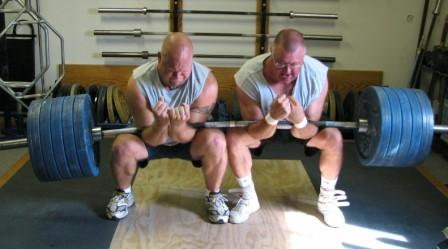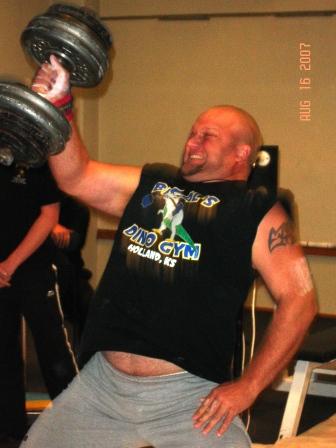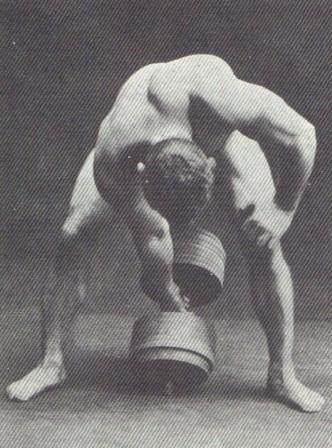TEAM LIFTING
by Al Myers
The date for the USAWA Team Nationals is approaching fast (Next Weekend -Sunday, September 20th, 2009). Team lifting is when two individuals (the Team) perform a lift together. The USAWA provides divisions for 2-Man, 2-Person, and 2-Woman Teams. A 2-person team is a team made up of a male and a female. All of these divisions are contested at the National Team Championships.

My training partner Chad Ullom (to left) and myself training the 2-Man Zercher Lift in preparation for the 2007 Team Nationals. We ended up lifting 705 pounds at Nationals.
Rules for Team Lifts (taken from the USAWA Rulebook)
“Any approved lift may be done as a Team Lift, provided it is done according to the rules of the individual lift. Team Lifts consist of two lifters performing a lift together. This may consist of male-male, female-female, or female-male teams. The combination of lifters may be of any age or weight. The weight class the Team will be in will be that of the heaviest lifter and the age class that of the youngest lifter. An exception is if a Junior lifter is teamed with an Open or Master lifter, in which the age class will be the class of the older lifter. “
Team lifting is very challenging because factors come into play that when lifting on a bar by yourself you don’t experience. The timing of the lift with your partner has to be the same or imbalances occur. It helps if both lifters are of the same height and body type so the bar is at the same height during and at the finish of the lift. Flexibility becomes more of a factor because of the limited space a bar provides when two lifters have a hold of it!! Lifting styles also come into play. For example – when doing a clean, one lifter can’t squat clean the bar while the other power cleans it!! Another factor you don’t think of until you actually do Team Lifting is trust. A missed lift can be catastrophic in team lifting because one person may be successfully completing the lift when this happens and unaware that one side of the bar is dropping fast!!! You have to know each others capabilities and be able to TRUST that your lifting partner won’t let you down.
But at the same time, Team Lifting provides a great challenge. In some lifts you can actually lift more together than the sum of each of your individual lifts. Chad and I found this out a couple of years ago when the Team One Arm Deadlift was contested at Team Nationals. We had an idea of what we thought we could do together based on each of our individual One Arm Deadlifts – but forgot a big difference that was going to occur when we were both gripping the bar. That difference was we were able to create an “alternate grip” on the bar by facing away from each other, thus helping in blocking the “bar roll” that occurs in any one arm deadlift. We ended up lifting more together than the sum of our “Bests” at the time.
There is still time to enter the USAWA Team Nationals.


